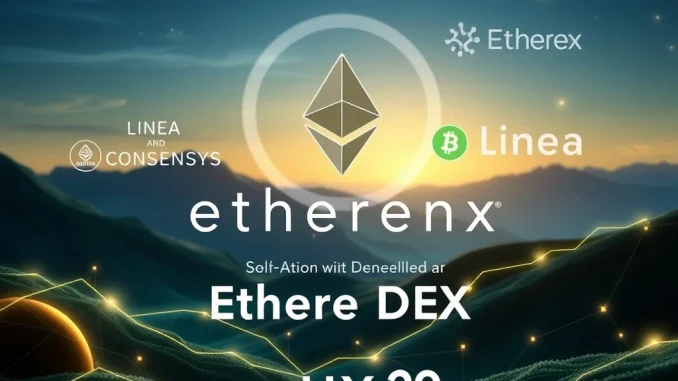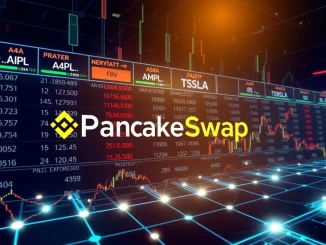
The decentralized finance (DeFi) landscape is constantly evolving, with innovations aimed at making cryptocurrency trading more efficient, secure, and accessible. A significant development is on the horizon that promises to reshape how we interact with decentralized exchanges. Get ready for the official launch of the Etherex DEX, a groundbreaking platform built on the cutting-edge Linea zkEVM, backed by the formidable expertise of Consensys.
Etherex DEX: A New Era for Decentralized Trading
Mark your calendars for July 28, because that’s when Etherex DEX, a brand-new decentralized exchange, is set to go live. This isn’t just another DEX; it’s a collaborative effort involving Linea, a leading zkEVM-based Ethereum Layer 2 network, Consensys, a titan in Ethereum infrastructure, and Nile, an existing decentralized exchange already operating on Linea. The synergy between these entities suggests a robust and well-supported platform designed to offer an optimized trading experience.
At its core, Etherex aims to provide a seamless and efficient environment for token swaps and liquidity provision. The launch signifies a commitment to pushing the boundaries of what’s possible within the DeFi space, leveraging advanced technology to address common pain points like high transaction costs and slow processing times. For users and liquidity providers alike, Etherex promises to be a vital addition to their DeFi toolkit.
Understanding Linea zkEVM: The Foundation for Etherex
The choice of Linea zkEVM as the underlying network for Etherex is a strategic one, highlighting the platform’s dedication to scalability and security. But what exactly is a zkEVM, and why is it so crucial for the future of decentralized applications?
A zkEVM, or Zero-Knowledge Ethereum Virtual Machine, is a type of Layer 2 scaling solution that significantly enhances the capabilities of the Ethereum blockchain. It achieves this by bundling hundreds or thousands of transactions off-chain and then generating a cryptographic proof (a ‘zero-knowledge proof’) that verifies the correctness of these transactions. This proof is then submitted to the Ethereum mainnet, dramatically reducing the data load and, consequently, transaction fees and confirmation times.
- Scalability: Linea processes transactions much faster than the Ethereum mainnet, allowing Etherex to handle a higher volume of trades without congestion.
- Cost-Efficiency: By aggregating transactions, Linea drastically lowers gas fees, making trading on Etherex more economical for users.
- Security: zkEVMs inherit the robust security of the Ethereum mainnet, as the validity of off-chain transactions is cryptographically proven, ensuring that Etherex operations remain secure and trustless.
- Ethereum Compatibility: Being an EVM-compatible network, Linea allows developers to easily deploy existing Ethereum smart contracts, fostering a familiar and accessible environment for dApps like Etherex.
This technological foundation positions Etherex to offer a superior trading experience, combining the decentralization and security of Ethereum with the speed and affordability of a Layer 2 solution.
Consensys’ Pivotal Role in Ethereum Infrastructure
The involvement of Consensys in the Etherex launch adds a significant layer of credibility and robust support. Consensys is a global blockchain software company, renowned for building foundational infrastructure, applications, and tools for the Ethereum ecosystem. Their portfolio includes widely used products like MetaMask, Infura, and Truffle, which have become indispensable for millions of users and developers in the Web3 space.
Consensys’s role in this collaboration extends beyond just a name; it signifies a deep commitment to fostering innovation within the Ethereum network. Their expertise in blockchain development, security, and ecosystem growth provides invaluable guidance and resources for the Etherex project. This partnership underscores the strategic importance of Etherex within the broader Ethereum landscape, suggesting a well-thought-out integration into the existing Web3 infrastructure. Consensys’s backing can inspire confidence among potential users and liquidity providers, knowing that the platform is supported by one of the most experienced and reputable firms in the blockchain industry.
REX Token: Powering Liquidity and Governance
A key component of the Etherex ecosystem is its native token, REX token. Designed to incentivize participation and foster a decentralized governance model, REX plays a crucial role in the platform’s economic mechanics. Here’s how it works:
REX tokens will be distributed as liquid rewards to liquidity providers (LPs) on Etherex. This mechanism is standard in many DEXs, aiming to attract and retain capital, ensuring sufficient liquidity for seamless trading. However, Etherex introduces an interesting twist with the xREX conversion:
| Token | Purpose | Key Feature |
|---|---|---|
| REX | Liquid Rewards for LPs | Directly earnable by providing liquidity. |
| xREX | Governance & Emission Voting | Converted from REX; enables voting on liquidity pool emission allocations. |
Users who convert their REX tokens into xREX gain the power to vote on emission allocations for their preferred liquidity pools. This innovative governance model empowers the community to directly influence where new REX tokens are minted, directing incentives to pools that they believe are most valuable or require more support. This system fosters a truly decentralized and community-driven platform, aligning the interests of LPs with the long-term health and growth of the Etherex DEX.
What Does This Mean for the Ethereum Layer 2 Ecosystem?
The launch of Etherex on Ethereum Layer 2 solutions like Linea zkEVM represents a significant step forward for the entire ecosystem. As Ethereum continues its journey towards greater scalability and efficiency, Layer 2 networks are becoming increasingly vital. Etherex, by building on Linea, demonstrates the practical application and benefits of these scaling solutions for high-demand DeFi protocols.
This development contributes to a more vibrant and competitive Layer 2 landscape. It encourages innovation among other Layer 2 projects and dApps, pushing the boundaries of what’s achievable in terms of transaction speed, cost, and user experience. For the average crypto user, it means more choices for efficient decentralized trading, potentially leading to a broader adoption of DeFi services.
Navigating the Future: Opportunities and Challenges for Etherex
The path forward for Etherex is filled with both immense opportunities and potential challenges. Its foundation on Linea zkEVM and backing by Consensys provides a strong starting point, but the DeFi market is fiercely competitive.
Opportunities:
- First-Mover Advantage on Linea: As one of the prominent DEXs launching on Linea, Etherex can capture significant early liquidity and user base.
- Scalability and Low Fees: The inherent advantages of zkEVM technology will attract users seeking efficient and cost-effective trading.
- Strong Backing: Consensys’s support lends credibility and potentially access to a wider user base through their existing products.
- Community Governance: The xREX model can foster a loyal and engaged community, crucial for long-term success.
Challenges:
- Market Saturation: The DEX market is crowded with established players. Etherex needs to consistently offer unique value to stand out.
- Liquidity Competition: Attracting and maintaining sufficient liquidity against deeply entrenched competitors will be ongoing.
- Security Audits & Trust: Despite the inherent security of zkEVMs, smart contract security and continuous auditing will be paramount to building user trust.
- User Adoption & Education: While Linea is promising, educating users about the benefits of a new Layer 2 DEX and encouraging migration will be key.
Actionable Insights for Potential Users and Liquidity Providers
If you’re considering engaging with Etherex DEX upon its launch, here are a few actionable insights:
- Research Thoroughly: Before committing capital, understand the specific risks and rewards associated with providing liquidity on a new DEX.
- Monitor Launch Details: Keep an eye on Etherex’s official channels (like their X account) for precise launch times, initial liquidity pools, and any early incentives.
- Understand REX & xREX: Familiarize yourself with the REX tokenomics and the xREX governance model. Decide if you prefer liquid rewards or participating in governance.
- Start Small: Consider allocating a smaller portion of your capital initially to gauge the platform’s performance and your comfort level.
- Security Practices: Always use a secure wallet and be wary of phishing attempts, especially around major launches.
Summary: A Promising Horizon for Decentralized Trading
The upcoming launch of Etherex DEX on July 28 marks an exciting moment for the decentralized finance community. With the robust foundation of Linea zkEVM and the strategic backing of Consensys, Etherex is poised to deliver a highly efficient and cost-effective trading experience. The innovative REX token and its xREX governance mechanism promise to create a truly community-driven platform, empowering liquidity providers with a voice in its development. As the Ethereum Layer 2 ecosystem continues to mature, Etherex stands as a testament to the ongoing innovation and the collective effort to build a more scalable, secure, and accessible future for decentralized trading. This launch is not just about a new exchange; it’s about pushing the boundaries of what’s possible in DeFi.
Frequently Asked Questions (FAQs)
Q1: What is Etherex DEX and when is it launching?
Etherex DEX is a new decentralized exchange built on the Linea zkEVM network. It is officially scheduled to launch on July 28.
Q2: What is Linea zkEVM and why is it important for Etherex?
Linea zkEVM is a Zero-Knowledge Ethereum Virtual Machine, which is an Ethereum Layer 2 scaling solution. It’s important for Etherex because it enables higher transaction speeds, lower fees, and enhanced security compared to the Ethereum mainnet, providing a more efficient trading experience.
Q3: What role does Consensys play in the Etherex launch?
Consensys, a major Ethereum infrastructure firm known for products like MetaMask, is a key partner in the Etherex launch. Their involvement provides robust support, credibility, and expertise in blockchain development and ecosystem growth, reinforcing the platform’s foundation.
Q4: How does the REX token work within the Etherex ecosystem?
The REX token is Etherex’s native token, distributed as liquid rewards to liquidity providers. These REX tokens can be converted into xREX, which grants users voting power to decide on emission allocations for specific liquidity pools, enabling decentralized governance.
Q5: What are the main benefits of using Etherex DEX?
The primary benefits of using Etherex DEX include significantly lower transaction fees and faster transaction speeds due to its Linea zkEVM foundation, enhanced security inherited from Ethereum, and a community-driven governance model through the REX and xREX tokens.
Q6: Is Etherex DEX safe to use?
While Etherex leverages the security of Linea zkEVM and has the backing of Consensys, like all decentralized platforms, it carries inherent risks. Users should always practice good security hygiene, such as using secure wallets and being aware of potential scams, and conduct their own research before engaging with any new platform.



